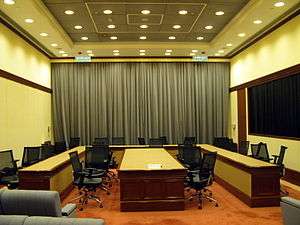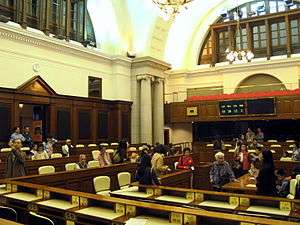Court of Final Appeal Building
| Court of Final Appeal Building | |
|---|---|
| 終審法院大樓 | |
 Viewed from across Chater Road. | |
| Former names |
Supreme Court Building Legislative Council Building |
| General information | |
| Type | Court building |
| Architectural style | Neo-classical |
| Location | Hong Kong |
| Address | 8 Jackson Road, Central |
| Coordinates | 22°16′52″N 114°09′36″E / 22.280996°N 114.160116°E |
| Completed | 1912 |
| Opening | 2015 (current use) |
| Renovated | 2013-2015 |
| Owner | Judiciary of Hong Kong |
| Dimensions | |
| Diameter | 70 m × 38 m (230 ft × 125 ft) |
| Design and construction | |
| Architect |
Sir Aston Webb Ingress Bell |
On the south side [of Statue Square] stands the New Law Courts. It was designed in England, and the only feature of note is the inartistic roof. Like all buildings erected by the Government, the edifice has been in course of construction nearly 15 years, and is still not completed. All the granite used in the construction of this massive block of buildings is the product of the Island and the mainland.
The Court of Final Appeal Building (Chinese: 終審法院大樓), also known as the Old Supreme Court Building (舊最高法院大樓), is the home of the Court of Final Appeal of Hong Kong. It housed the former Supreme Court from 1912 to 1983 and the Legislative Council from 1985 to 2011. It is located at 8 Jackson Road, in Central,[2] along the eastern side of Statue Square, directly west of Chater Garden. As the Old Supreme Court, its exterior is one of the declared monuments of Hong Kong.
History
The building was designed by Sir Aston Webb and Ingress Bell,[3] the British architects responsible for the eastern façade of Buckingham Palace[2] and the Cromwell Road frontage of the Victoria and Albert Museum in London.
Construction of the Building started in 1900 and it was opened on 15 January 1912 by the Governor Sir Frederick Lugard.[2] The two-storey granite building is neo-classical in style supported by Ionic columns. It is surmounted by a 2.7 m high blind-folded statue of Justice, represented by Themis, the Greek Goddess of Justice and Law.[3] This statue is inspired by the one erected on the Old Bailey of London.
During the Japanese occupation of Hong Kong (December 1941 to August 1945), the building was used as the headquarters of the Kempeitai (Military Police).[2]
In 1978, this building was severely affected by the construction of MTR; therefore, it had to undergo some restoration afterwards.[3] As a consequence, for a time in the early 1980s, the Supreme Court was moved to the Former French Mission Building,[4] which was then used by the Victoria District Court.
The building became the Legislative Council Building in 1985, and the Supreme Court was moved to the Supreme Court Building in Admiralty and was renamed the High Court Building in 1997.
In 2011 the Legislative Council was moved to the Legislative Council Complex within the Central Government Complex at Tamar site.
On 7 September 2015,[5] the building reverted to its former judicial function. It is now housing the Court of Final Appeal. The opening ceremony was held on 25 September 2015 by the Chief Justice of the Court of Final Appeal Geoffrey Ma Tao-li.[6]
Architectural features
The Building was erected on reclaimed land. Its foundation was formed by driving hundreds of Chinese fir tree trunks into the mixture of reclamation materials and silt on the site. As a consequence, the Building is in effect "floating" on a timber raft. Such a foundation system requires the groundwater level to be maintained at a constant level, and a groundwater replenishment system is installed to replace groundwater as required.[2]
The plan of the Building follows a rectangular pattern and is symmetrical. The Building occupies an area of around 2,660 square metres (28,600 sq ft) (about 70 by 38 metres (230 ft × 125 ft)) and is surrounded by columns. The height of the building, from street level to the highest point, which is in the form of a bronze Tudor Crown, is about 40 metres (130 ft).[2]
A pediment surmounts the central section of the Building facing Statue Square. The pediment is topped by a Statue of Justice and under it is the inscription "Erected AD MDCCCCX" (Erected AD 1910). The pediment incorporates a semi-circular window and the carving of the British Royal Coat of Arms is above it. The shield shows the various royal emblems of the various parts of the United Kingdom: the three lions of England in the first and fourth quarters, the lion of Scotland in the second and the harp of Ireland in the third. The shield is supported by the English lion and Scottish unicorn and is surmounted by the Royal crown. The motto of the Sovereign, Dieu et mon droit (God and my right), is displayed underneath it. The figures of Mercy and Truth are located on both sides of the British Royal Coat of Arms.[2]
Gallery
Interior of the building as the Legislative Council Building (1985 to 2011)
-

Conference Room A
-

Conference Room B
-

Conference Room C
-

President's office
-

Press Conference Room
-

Office for the members of the Legislative Council
-

Ante Chamber
-

President's seat
-

Dining Hall
-

Ceiling of the Main Chamber
-
Chamber interior
-

Chamber interior
See also
- Court of Final Appeal of Hong Kong
- Supreme Court of Hong Kong
- Legislative Council Complex
- Central and Western Heritage Trail
- Former Central Magistracy
- List of buildings and structures in Hong Kong
References
- ↑ Picturesque Hong Kong: a handbook for travellers. Hong Kong: Tillotson & Sons. 1911.
- 1 2 3 4 5 6 7 Legislative Council Secretariat: Information note IN26/02-03: The Legislative Council Building
- 1 2 3 "The Legislative Council Building". Legislative Council. Archived from the original on November 23, 2011.
- ↑ Roberts, Denys (Apr 18, 2006). Another Disaster: Hong Kong Sketches. The Radcliffe Press. pp. 87–88. ISBN 9781845111120.
- ↑ https://www.hongkongfp.com/2015/09/07/court-of-final-appeal-moves-into-former-legislative-council-building/
- ↑ http://www.globalpost.com/article/6656687/2015/09/25/hong-kongs-court-final-appeal-building-opens
External links
| Wikimedia Commons has media related to The Court of Final Appeal Building. |
Coordinates: 22°16′52″N 114°09′36″E / 22.280996°N 114.160116°E
| Preceded by Exchange Building |
Home of the Supreme Court of Hong Kong 1912–1981 |
Succeeded by Former French Mission Building |
| Preceded by Central Government Offices – Main Wing |
Home of the Legislative Council of Hong Kong 1985–1997 |
Succeeded by None – see Provisional Legislative Council |
| Preceded by Shenzhen Guesthouse Hotel |
Home of the Provisional Legislative Council of Hong Kong 1997–1998 |
Succeeded by Legislative Council Building as home to Legislative Council of Hong Kong SAR |
| Preceded by None – refer to Provisional Legislative Council |
Home of the Legislative Council of Hong Kong SAR 1998–2011 |
Succeeded by Legislative Council Complex |
| Preceded by Former French Mission Building |
Home of the Court of Final Appeal of Hong Kong SAR 2015 – present |
Succeeded by current |
| ||||||||||||||||||||||||||||||||||||||